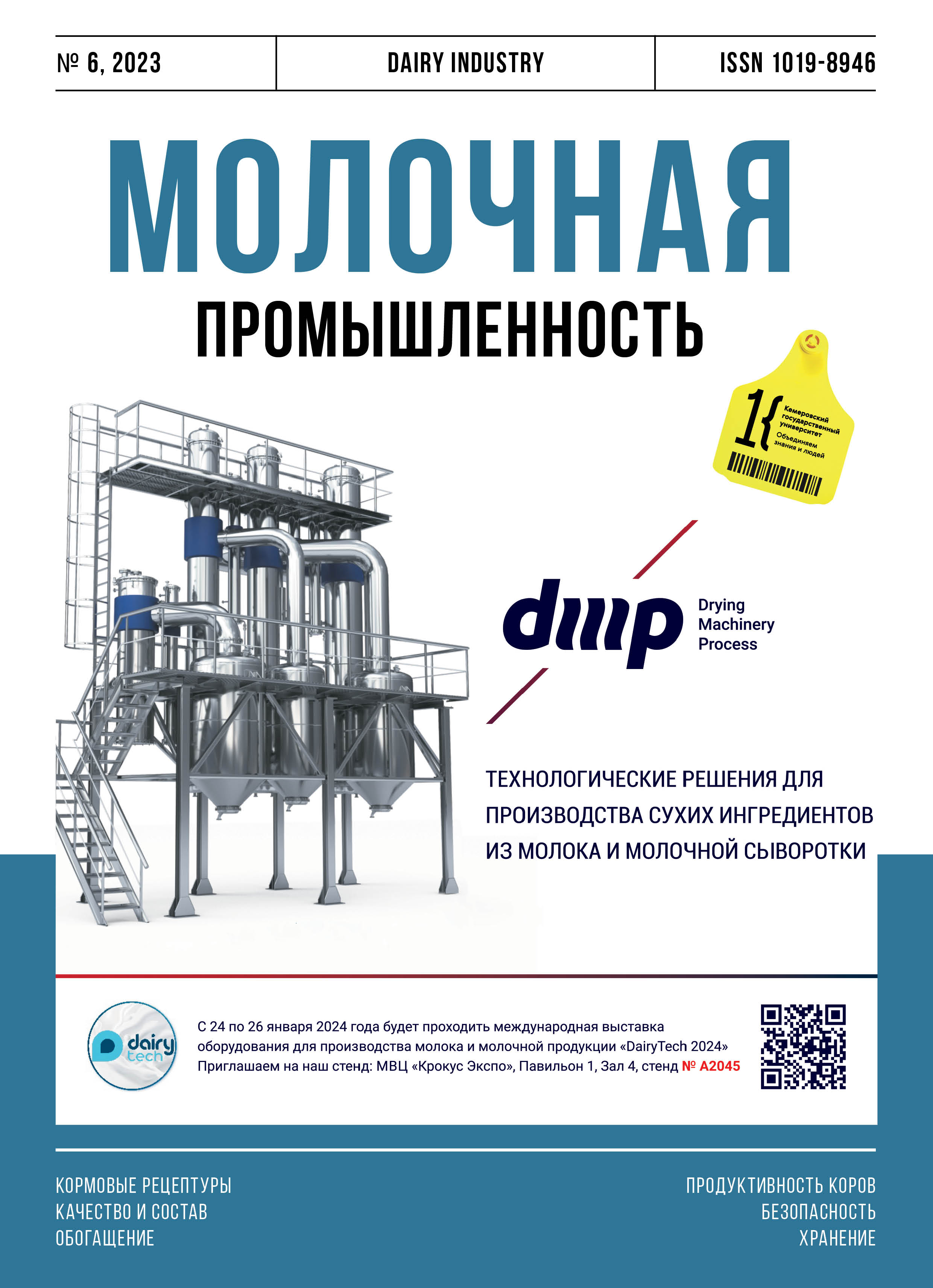Uglich, Russian Federation
Uglich, Russian Federation
Uglich, Russian Federation
Mesophilic lactococci strains of Lactococcus lactis subsp. lactis and Lactococcus cremoris are part of many fermented dairy products, including cheeses. As a rule, they serve as the main acid agents in bacterial starter cultures. Throughout all technological stages of cheese production, these microorganisms encounter various factors that affect their growth and metabolism. Despite its widespread industrial use and accumulated scientific knowledge, the question still remains of how lactococci behave during production. This article provides a comparative assessment of temperature-related development processes and acid formation in lactococci Lactococcus lactis subsp. lactis and Lactococcus cremoris. The strains showed no differences in culture development rate or acid-forming activity under optimal thermostating conditions during the deep liquidphase cultivation in milk. These variables were measured by the increase in titratable acidity (°T) and the decrease in active acidity (pH). The lactococci developed and metabolized carbohydrates at (10 ± 1) °C, which allowed for acid formation processes during the cheese ripening stage. Both strains showed significant psychrotrophy. Their development and metabolism were interrupted at (4 ± 1) °C, which made it possible to avoid the risk of reducing the storage capacity of fermented dairy products under the effect of lactococci starter. The greatest risks of using Lactococcus cremoris starter cultures were associated with their low thermal stability, which made the strains sensitive to temperatures above (40 ± 1) °C.
bacterial starter cultures, lactic acid microorganisms, lactococci, acid forming activity, technically significant temperatures
1. Wedajo, B. Lactic Acid Bacteria: Benefits, Selection Criteria and Probiotic Potential in Fermented Food / B. Wedajo // Journal of Probiotics & Health. 2015. № 03(02). P 1-9. https://doi.org/10.4172/2329-8901.1000129
2. Klaenhammer, T. Discovering lactic acid bacteria by genomics / T. Klaenhammer, E. Altermann, F. Arigoni [et al.] // Antonie Van Leeuwenhoek. 2002. № 82(1-4). P. 29-58. https://doi.org/10.1007/978-94-017-2029-8_3
3. Johansen, E. Use of Natural Selection and Evolution to Develop New Starter Cultures for Fermented Foods / E. Johansen // Annu Rev Food Sci. Technol. 2018. № 25. P. 411-428. https://doi.org/10.1146/annurev-food-030117-012450
4. Nicosia, F. D. Technological Characterization of Lactic Acid Bacteria Strains for Potential Use in Cheese Manufacture / F. D. Nicosia, A. Pino, G. L. R. Maciel [et al.] // Foods. 2023. № 12. 1154. https://doi.org/10.3390/foods12061154
5. Ayad, E. H. E. Selection of wild lactic acid bacteria isolated from traditional Egyptian dairy products according to production and technological criteria / E. H. E Ayad, S. Nashat, N. El-Sadek [et al.] // Food Microbiology. 2004. V. 21. I. 6. P. 715-725. https://doi.org/10.1016/j.fm.2004.02.009
6. Mordvinova, V. A. Faktory, vliyayuschie na kachestvo syrov tipa "Maasdam" / V. A. Mordvinova, G. M. Sviridenko // Syrodelie i maslodelie. 2015. № 3. S. 28-30.
7. Mordvinova, V. A. Kachestvo i hranimosposobnost' produktov syrodeliya: osnovnye faktory / V. A. Mordvinova // Syrodelie i maslodelie. 2011. № 5. S. 9-11.
8. Pessione, A. Proteomics as a tool for studying energy metabolism in lactic acid bacteria / A. Pessione, C. Lambertia, E. Pessione // Molecular BioSystems. 2010. I. 8. P. 1419-1430. https://doi.org/10.1039/C001948H
9. Hamitova, A. R. Faktory vneshney sredy, vliyayuschie na process brozheniya / A. R. Hamitova // Nauka i obrazovanie: problemy i tendencii razvitiya. 2016. № 1. S. 10-12.
10. Sviridenko, G. M. Ocenka mikrobiologicheskih riskov v proizvodstve molochnyh produktov / G. M. Sviridenko // Pererabotka moloka. 2010. № 4. S. 6-9.
11. Grunskaya, V. A. Analiz mikrobiologicheskih riskov pri proizvodstve kislomolochnyh produktov / V. A. Grunskaya, S. V. Ivanova, A. A. Ababkova // Molochnohozyaystvennyy vestnik. 2013. № 2 (10). S. 30-35.
12. Samaržija, D. Taxonomy, physiology and growth of Lactococcus lactis: a review / D. Samaržija, N. Antunac, J. L. Havranek // Mljekarstvo. 2001. T. 51. № 1. P. 35-48.
13. Carr, F. J. The lactic acid bacteria: a literature survey / F. J. Carr, D. Chill, N. Maida // Critical reviews in microbiology. 2002. T. 28. №. 4. P. 281-370.
14. Bintsis, T. Lactic acid bacteria as starter cultures: An update in their metabolism and genetics / T. Bintsis // AIMS microbiology. 2018. T. 4. № 4. P. 665.
15. Ibrahim, S. A. Lactic Acid Bacteria as Antimicrobial Agents: Food Safety and Microbial Food Spoilage Prevention / S. A. Ibrahim, R. D. Ayivi, T. Zimmerman [et al // Foods. 2021. № 10. https://doi.org/10.3390/foods10123131
16. Sviridenko, G. M. Razvitie i metabolizm Lc. lactis subsp. cremoris pri razlichnyh tehnologicheskih priemah proizvodstva sozrevayuschih syrov / G. M. Sviridenko, O. M. Shuhalova // Molochnaya promyshlennost'. 2022. № 8. S. 36-38.
17. Gudkov, A. V. Syrodelie: tehnologicheskie, biologicheskie i fiziko-himicheskie aspekty / A. V. Gudkov. - M.: DeLi print, 2003. - 800 s.






